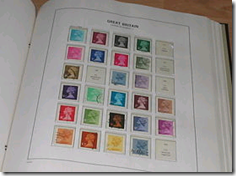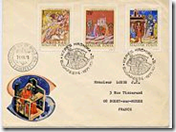Here is an excerpt from Wikipedia about Postage Stamp Collecting:


Stamp collecting is the collecting of postage stamps and related objects, such as covers (envelopes or packages with stamps on them). It is one of the world's most popular hobbies, with estimates of the number of collectors ranging up to 20 million in the United States alone. Collecting is not the same as philately, which is the study of stamps. A philatelist often does, but need not, collect the objects of study, nor is it necessary to closely study what one collects. Many casual collectors enjoy accumulating stamps without worrying about the tiny details, but the creation of a large or comprehensive collection generally requires some philatelic knowledge.

The first postage stamp, the Penny Black, was issued by Britain in 1840. It pictured a young Queen Victoria, was produced without perforations (imperforate), and consequently had to be cut from the sheet with scissors in order to be used. While unused examples of the "Penny Black" are quite scarce, used examples are common, and may be purchased for $25 to $150, depending upon its condition.

Children and teenagers were early collectors of stamps in the 1860s and 1870s. Many adults dismissed it as a childish pursuit. During the late 1800s many of those collectors, as adults, began to systematically study the available postage stamps and published research works on their production, plate flaws, etc. Some stamps such as the triangular issues of the Cape of Good Hope became legendary.
Stamp collecting is a popular hobby, and stamps are often produced as collectibles. Some countries are known for producing stamps intended for collectors rather than postal use. This practice produces a significant portion of the countries' government revenues. This has been condoned by the collecting community for places such as Liechtenstein and Pitcairn Islands that have followed relatively conservative stamp issuing policies. Abuses of this policy, however, are generally condemned. Among the most notable abusers have been Nicholas F. Seebeck and the component states of the United Arab Emirates. Seebeck operated in the 1890s as an agent of Hamilton Bank Note Company when he approached several Latin American countries with an offer to produce their entire postage stamp needs for free. In return he would have the exclusive rights to market the remainders of the stamps to collectors. Each year a new issue of stamps was produced whose postal validity would expire at the end of the year; this assured Seebeck of a continuing supply of remainders. In the 1960s certain stamp printers such as the Barody Stamp Company arranged contracts to produce quantities of stamps for the separate Emirates and other countries. These abuses combined with the sparse population of the desert states earned them the reputation of being known as the "sand dune" countries.
The combination of hundreds of countries, each producing scores of different stamps each year has resulted in a total of some 400,000 different types in existence as of 2000. In recent years, the annual world output has averaged about 10,000 types each year.



